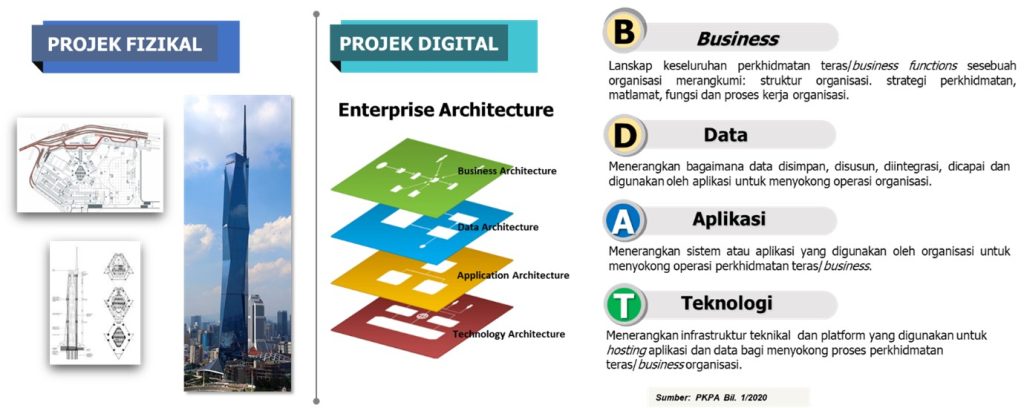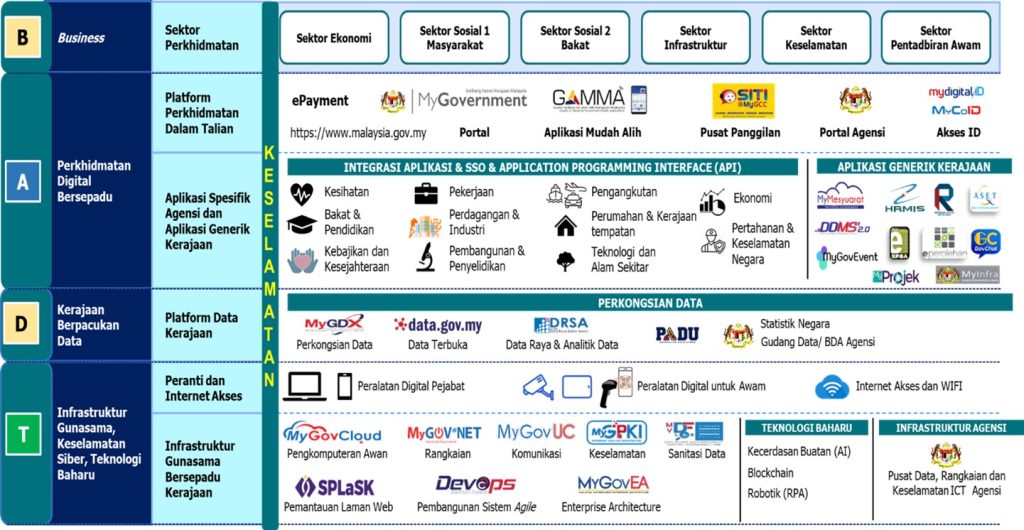Digital Transformation: Malaysia on the World Digital Economy Stage
The Evolution of Public Sector Digitalization
The digitalization of the public sector in Malaysia has undergone a long and continuous transformation journey, making the country a leader in the digital delivery of government services. Beginning more than three decades ago, this effort is based on technological innovation and a people-centric approach to improve the efficiency, transparency, and accessibility of public services.
Starting in 1995 with the Multimedia Highway Corridor (MSC) initiative , the government took the first steps towards digitalisation through the transformation of administrative processes and service delivery using ICT and multimedia. In 2000, the National IT Agenda (NITA) was introduced to harness ICT technology in driving national development while bridging the digital divide among the people. Subsequently, in 2007, the eGov 1.0 – Connected Government phase , promoted the use of technology in everyday life.
In 2015, the government introduced eGov 2.0 – Collaborative Government, a “Whole of Government” approach that aims to improve integration and productivity between government agencies in a more integrated manner. Then, in 2020, the eGov 3.0 – Digital Government phase marked a shift to people-centric services, guided by strategic documents such as the Malaysia Digital Economy Blueprint (2021-2025). By 2025, the government will focus on GovTech with the Digital First Strategy Shift (2024-2025) as the main driver, using technology to drive the growth of the digital economy. This initiative also introduced the concept of MADANI Economy as the foundation for sustainable digital economic development.
This evolution reflects the government’s continued efforts to improve efficiency, inclusiveness, and service delivery to the people. This evolution not only strengthens the role of technology in public administration but also ensures that Malaysia remains a leader in the regional digital economy.

Whole-of-Government Enterprise Architecture Approach to Public Sector
Enterprise Architecture (EA) enables an organization to identify and streamline the services it provides by understanding the overall organizational structure. This includes the functions performed, the services offered, the work processes involved, the data used, and the applications and technologies that support those services.

In other words, EA provides a framework that underpins the development of public sector digital/information and communication technology (ICT) initiatives, much like an architect’s blueprint is used in the development of a physical project to show the design, structure, and technology requirements. EA enables organizations to gain a clear and detailed picture of their operations. This deep understanding is essential to identify areas for improvement, eliminate duplication, and ensure that resources are used optimally. Ultimately, EA helps organizations deliver more efficient, effective, and responsive services to their customers or stakeholders.
The Whole-of-Government (WoG) approach to the delivery of government digital services is structured and coordinated across six key sectors. The Sector Coordination Meeting, chaired by the Director General of the National Digital Department (JDN), plays a key role by bringing together Digital Teams from various key sectors. The WoG ecosystem relies on application integration, a preference for generic government applications, shared data, and supported by the use of standard technologies. This strategy promotes efficiency and reduces duplication in the delivery of efficient and integrated services to the public.

The Whole-of-Government (WoG) concept and Enterprise Architecture (EA) are two interrelated elements in the evolution of public sector digitalization. The WoG approach promotes collaboration and integration between government agencies to deliver services in a more holistic and citizen-centric manner. To achieve this goal, EA provides a comprehensive framework that guides the planning, design, and implementation of digital initiatives. By using EA, government agencies can ensure that their systems and applications are interoperable, data can be easily shared, and ICT resources are optimally utilized, thereby supporting the effective implementation of the WoG strategy.
National Digital Department
Levels 1-6,
MKN Embassy Techzone Building
Block B, No. 3200
Jalan Teknokrat 2
63000 Cyberjaya, Sepang
Selangor Darul Ehsan
Tel: 603-8000 8000
Email: webmasterjdn@jdn.gov.my
Today’s Visitors: 232
Number of Visitors: 110177
Total Reach: 1092059
This site is best viewed using the latest version of Microsoft Edge & Google Chrome web browsers with a minimum resolution of 1366×768.